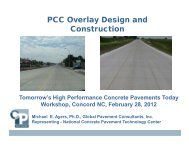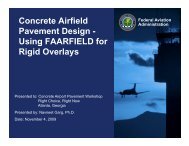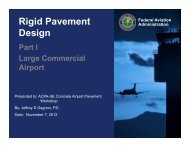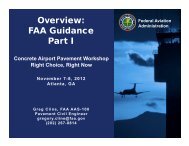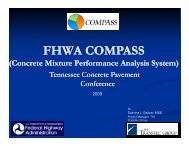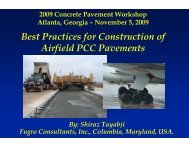John Rone, PE
John Rone, PE
John Rone, PE
You also want an ePaper? Increase the reach of your titles
YUMPU automatically turns print PDFs into web optimized ePapers that Google loves.
Concrete Pavement Repair &Maintenance at Hartsfield-JacksonAtlanta International Airport<strong>John</strong> <strong>Rone</strong>, P.E.Aviation EngineerHartsfield-Jackson Atlanta International Airport1
AgendaI. ATL FactsII. Why?III. Pavement MaintenanceIV. Locating and Evaluating DistressesV. Preparing Plans and SpecificationsVI. Repairing DistressesVII.Recording Repairs2
I. ATL Facts• Busiest Airport in the World• Over 930,000 operations per year• Over 90 million passengers per year• 5 Runways – averaging 2,700 daily operations• 21 Taxiways• Over 40 million S.F. of PCC pavement• Approximately $2 Billion3
I. ATL Facts4
Runway Construction & SectionsRunway Year Section Slab Size8L-26R 84-85 16/6/6 25’x50’8R-26L 2006 20/2/6 25’x25’9L-27RCenter 1974 16/6/6 25’x75’E 2,100’ 1985 16/6/6 25’x50’W 1,800’ 1985 16/6/6 25’x50’9R-27L 1999 18/4/6 25’x25’10-28 2006 20/9 25’x25’5
I. ATL Taxiways• Organized For Inspection – 14• Grouped by major parallel• Sierra and Tango with November, 9L-27R, andMike• Constructed between 1964 and 2011• M10, M12• Lima and Mike6
II. Why?• Safety - Aircraft7
II. Why?• Safety - People8
II. Why?• Asset Preservation• Operational Impact• Operations per day• Arrival Runway 1,002• Departure Runway 1,0059
III. Pavement Maintenance• Three Major Categories, Two EntitiesA. Emergency Repairs – DOA MaintenanceB. Major Replacements – DOA P&DC. Annual Repairs – DOA P&D10
A. Emergency Repairs• Methyl Methacrylate• Restek MMA-basedpolymer concrete11
A. Emergency Repairs• Revere Sta-Fil asphalt patch• Replaced with Restek within 10 months12
B. Major Replacements: 5-Year Plan14
C. Annual Repairs• Scope Screening• Safety• Preservation of Assets• Part 139 Compliance15
C. Annual Repairs• Typical Project Scope• Striping and Markings• Grading• Shoulder Rejuvenator (As needed)• PCC Repairs16
C. Annual Repairs PCC Scope• Joint Seal• Crack Routing and Sealing• Spalls• Utility Spalls• Trench Drains• Full Depth Slabs17
IV. Locating & Evaluating DistressesA. Runway and Taxiway InspectionsB. Field Data Collection Techniques18
A. Runway and Taxiway Inspections• Total Inspection Area• Approximately 23 million square feet• Total Nights• 16-18• Average Area Per Night• 1,350,000 square feet• Distances Covered• Typically Between 5 and 8 miles19
B. Field Data Collection Techniques• Typical Night• Arrive 9:00 - 10:00• Check survey equipment• Check weather• Confirm with Maintenance and Airside Operations• Go to field• Meet light plants• Inspect• Return to Tech Campus20
Our Equipment• RTK System• Paint Wand• Dowel Bar• Flashlights• Radios• Juno21
Maintenance Equipment• Trucks (2)• Light Plants (2)• Alert Drivers22
Pavement Inspections• Runway Closures 2330-0630• Closed to hold bars – 290 feet• Mainline then connectors• Easiest way to organize• No backtracking• Taxiway Closures - Unit 5 Dependent• Some: Rolling closures between connectors• Others: Open – “You should be o.k.”• 747 in the dark• Mainline then connectors23
Pavement Inspections• Monitoring Radios• Especially for active pavements• City for Unit 5• South Cargo – R6 and KAL• Tower for Aircraft• Crossings• Location of aircraft24
Arrival at Distress• Spalls, Utility Spalls, and Trench Drains• Sound with dowel bar to finddelaminated area• Mark perimeter• Evaluate severity• High• Medium• Low25
Arrival at Distress• Survey with GPS unit• Start at SW corner, shootCCW• Differing codes• Changes description field• Paint number onpavement• Photograph• From SW corner26
Arrival at Distress• Joint Seal, Crack Seal, and Full Depth Slabs• Mark vertices• Survey with GPS unit27
Distress Field Evaluation• Spall Distress Types• High Severity• Medium Severity• Low Severity• Watch• Typically an existing patch• May sound slightly hollow• Modify by Location – Engineering Judgment• Age• Traffic28
Evaluation - High Severity Spall• Must be addressed this year• Active FOD Producers• High Traffic Locations29
Evaluation - Medium Severity Spall• Should be addressed this year• FOD potential• Lower traffic30
Evaluation – Low Severity Spall• Will not appreciably deterioratewithin a year• Repairs by Maintenance• Existing hollow patches• Low FOD potential31
Evaluation - Utility Spalls• Utility Spalls• Conduits cut intopavement32
Evaluation – Joint Seal• Missing• Damaged/Not Adhering33
Evaluation – Crack Sealing• Judgment34
Evaluation - Trench Drains• Sound of wall• No energy return35
Evaluation – Full Depth Slabs• Pavement Evaluation Report• When spall repairs are not enough36
Distresses – Potential Causes• Improper Dowel Bar Alignment - Spalls37
Distresses – Potential Causes• Consolidation• Age/Loads• How do you make PCClast?• Location of Reinforcing• No steel?• Too Deep?38
Distresses – Potential Causes• Materials39
Distresses – Potential Causes• Own Worst Enemy40
Field Work Completion• Download survey data• Save photos• Equipment on chargers• E-mail Airside Ops for next day’s closure• Update AutoCAD basemap with area inspected• Update actuals spreadsheet with area and timerequired• Forecast time required for next area• Target 1,000,000 S.F. min.41
V. Preparing Plans and Specifications• AutoCAD Base Drawing• Import field data• Connect points• Photos are critical• Offset limits at joints• 6” offset• Measure quantities• In drawing• Tracking• Quantities• Spall master list• Can zoom to anypoint• Ops• Distress Drawings42
Construction Details43
Construction Details• Utility Spall44
Closure Plan Requirements• Closure times• Full Slabs: 2200 – 0800• Trench Drains: 24-hours until completion• Other Repairs: 2330 - 063045
Specification Requirements• Spalls – High Early• Materials• High-early strengthcement – Approx. 900lbs.• Polymer fibers• #7 or #89 stone• Flexural Strength• 400 psi at 4 hours• 700 psi at 24 hours• 4 hours of cure timerequired• Slab Replacements• Materials• High-early strengthcement• Flexural Strength• 500 psi at 4 hours• 750 psi at 28 days• Trench Drains• Materials• Type III cement• #7 stone for amount ofrebar• CompressiveStrength• 2,500 psi at 3 days• 3,000 psi to open46
VI. Repairing Distresses• Joint Seal• Crack Seal• Spalls, Utility Spalls, Slab Replacements47
Joint Seal Repair• Remove sealant• Saw cut, rebevel• Sandblast• Air wand• Insert backer rod• Install sealant• Width• 25- and 50-foot slabs:3/8”• 75-foot slabs: 1/2”• Expansion: 1-1/2”• Trench DrainExpansion: 3”• Set down• Taxiways and Aprons:3/8”• Runways:1/2”48
Crack Seal Repair• Rout to 3/8” width and 3/8” depth• Sandblast• Air wand• Insert backer rod• Install sealant49
Spall Repair• Typical Spall Repair Sequence• Pre-sawing• Mass demolition• Fine demolition• Debris removal• Bobcat• Brooms• Air wand• Sandblasting50
Spall Repair• Typical Spall RepairSequence, Cont.• Drill rebar holes• Epoxy• Place reinforcingsteel• Set expansionmaterial• Clean• Grout• Place concrete• Consolidate• Finish• Cure51
Pop Quiz1. Is this a distress?52
Pop Quiz2. Is this dowel bar installed at the properdepth?53
Pop Quiz3. Is something missing?54
Pop Quiz4. Does this joint meet spec?55
Pop Quiz5. If there’s white paint covering the box atHome Depot, should you buy it?56
Spall Repair: Tango at 9L-27R• Sample Spall Repair Location• Between 9L-27R and November on Tango• Spall 5634, Northern• Spall 5641, Southern• Areas• Spall 5634 – 29 S.F.• Spall 5641 – 23 S.F.• Total time• 2350 – 0301• 3 hours, 11 minutes57
2350 at ATL58
2350 E.T. 00:00• Lighted Xs placed• Vehicles enter runway59
0004 Demolition E.T. 00:14• After barricade placement at 2352• Demolition begins60
0015 Mass Demolition E.T. 00:25• Initial debris clearing61
0015 – 0040 Concurrent Activities• Concurrent with demolition, other areas arepre-sawed62
0015 – 0040 Concurrent Activities• To prevent overcuts, corners are cored63
0015 -0040 Concurrent Activities• Reinforcing steel being prepared64
0015 -0040 Concurrent Activities• Bulk of debris is swept up and removed65
0040 Fine Demolition E.T. 00:50• Chipping hammer used to smooth bottom66
0040 E.T. 00:50• Saw used to cut existing patch bars67
0051 Air Wand E.T. 01:01• High pressure air used to remove debris68
0105 Sandblasting E.T. 01:15• Sandblasting spall 5634 to roughen surfaces• Air wand after69
0115 Sandblasting E.T. 01:25• Sandblast spall 564170
0115-0135• Pavement distress for next night71
0115-0135 Drilling• Drilling for rebar in spall 563472
0145 Epoxy E.T. 01:55• Inject Epoxy for Reinforcing Steel73
0205 Expansion Material E.T. 2:15• Expansion Board Placed75
0219 Ready for Final Cleanup E.T. 2:29• Spall 5634 Reinforcing Complete76
0219 Air Blasting E.T. 2:29• Air Blast Spall 563477
0225 Concrete Placement E.T. 2:35• Zimmerman Volumetric Mixer Backed intoPlace78
0227 Concrete Placement E.T. 2:37• Water Sprayed into Spall 564179
0231 Concrete Placement E.T. 2:41• Material Tested into Bobcat• Grout Applied80
0236 Concrete Placement E.T. 2:46• Spall 5641 concrete placed and consolidated81
0237 Concrete Placement E.T. 2:47• Concrete Placement Completed at Spall 564182
0239 Finishing E.T. 2:49• Strike-off and Finishing at Spall 564183
0240 Concurrent Activities E.T. 2:50• Beams being Made84
0244 Concrete Placement E.T. 2:54• Concrete Placement at Spall 563485
0251 Concurrent Activities E.T. 3:01• Beams Covered with Wet Burlap86
0252 Finishing E.T. 3:02• Finishing Complete at Spall 564187
0252 Concurrent Activities E.T. 03:02• More Sweeping88
0254 Finishing E.T. 3:04• Finishing Continues at Spall 563489
0254 E.T. 3:04• Wet Burlap on Spall 564190
0301 E.T. 3:11• Finishing Complete on Spall 563491
0301 E.T. 3:11• Wet Burlap on Spall 563492
VII. Recording Repairs93
Questions<strong>John</strong> <strong>Rone</strong>, P.E.Aviation EngineerHartsfield-Jackson Atlanta InternationalAirport94



